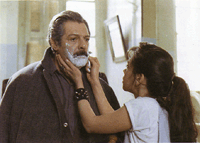The Beekeeper opens to a static shot of an extended dinner table festively covered with a white tablecloth and ornamented with rose petals that is sitting empty at the center of the courtyard in the rain, as the sound of Spyros’ (Marcello Mastroianni) affectionate voice is heard recounting to his young daughter the natural selection process of bees that culminates in the majestic queen’s dance. The guests have retreated indoors for what is revealed to be the wedding reception of Spyros’ daughter – now a grown woman – in the family home. From the onset, the middle-aged schoolteacher’s profound disconnection is immediately palpable as he shares a prolonged, uncomfortable silence with his wife (Jenny Roussea) while picking up shards of broken glass from an overturned tray of wine glasses. Dispirited by his inevitable separation from his beloved daughter, Spyros separates from his wife and embarks on his forefathers’ traditional vocation of apiculture. Traveling southward with his bees on an instinctual springtime migration, Spyros encounters a young hitchhiker (Nadia Mourouzi) who, abandoned on a rural truck stop, insinuates herself on the resigned and acquiescent Spyros through intermittent points on his indeterminate journey. Estranged from an unfamiliar modern world where his generation has become a historically incidental relic, Spyros attempts to reconnect with humanity through the promiscuous and rootless young woman and, in the process, retreats further into the solitude of his dying avocation.
The Beekeeper is a haunting, compassionate, and profoundly melancholic portrait of isolation, dislocation, estrangement, and obsolescence. Using episodically contrasting imagery of union and separation, Theo Angelopoulos provides a sustained visual metaphor for the film’s pervasive themes of fracture and disintegration: the assembly of family members for a formal wedding photograph that is followed by their individual departure from the family home, first by the daughter and her new husband, then the wife and son, and finally, Spyros; the opening sequence of the extended dinner table that is representationally shown in fragmented form through repeated shots of empty bistro tables as Spyros re-encounters the hitchhiker; the image of shattered wine glasses that is repeated in Spyros’ impulsive crashing of his vehicle into a restaurant plate window in order to reunite with the young woman; the organized matrix of apiculture boxes during transit that is subsequently shown as individual containers randomly scattered along a hillside open field (that provides visual continuity with the overlooking houses of a distant village). Achieving a visual dichotomy that is both patternistic and deconstructive, the film serves as an indelible chronicle of the destruction of tradition and family, the cultural erosion of contemporary Greek society, and the desolation of the human soul.
© Acquarello 2003. All rights reserved.
